Control Study on Surrounding Rock of Gob-Side Entry Retaining below near Distance Goaf
Abstract
1. Introduction
2. Analysis of Engineering Geological Conditions
2.1. Production and Geological Conditions of Roadways and Panels
2.2. Control Difficulties for GSER Surrounding Rock below near Distance Goaf
- (1)
- Poor geological conditions. Firstly, the distance between the UCS and LCS is only 11.5 m. When mining the UCS, it will cause multiple mining ruins to the roof of the LCS. The integrity of this roof will be ruined before mining the LCS, resulting in not having a stable rock mass with sufficient thickness to reinforce the roof during mining of the LCS, causing great difficulties for the support of the GSER below near distance goaf. Secondly, after the completion of the UCS mining, the roof of the LCS is covered with collapsed gangue from the UCS goaf, resulting in changes in the stress state and structure of the surrounding rock of the LCS. Finally, the remaining coal pillars will generate concentrated stress and transmit it along the floor to the LCS, requiring optimization of the mining roadway layout of the LCS.
- (2)
- The stress environment of the roadway surrounding rock is complex and varied. Due to the burial depth of 620 m in 3# coal seam, the vertical stress and horizontal stress around the roadway is relatively high. Moreover, horizontal stress is predominant near the roadway, with values slightly greater than vertical stress. At the same time, the 2303 panel needs to experience strong mining impacts from the dynamic pressure of the mining of the upper 2203 and 2205 panel, the excavation of the mining roadway in 2303 panel, the mining of 2303 panel, and the mining of 2305 panel. Therefore, the stress of the GSER surrounding rock the is complex and variable, and it is necessary to conduct in-depth research on the control mechanism of the GSER below near distance goaf and comprehensively determine a reasonable and reliable GSER support system.
- (3)
- It is difficult to control the GSER surrounding rock formed by RFW. When carrying out roadside filling operations, there is usually a risk of injury caused by debris falling off the roof after the hydraulic support is pushed in, a risk of roof collapse due to untimely strengthening of support, and a risk of injury caused by splashing of gangue in goaf, which poses significant difficulties for roadside filling operations. In addition, the RFW belongs to narrow walls. The narrow width of the RFW poses a new challenge to the control technology of the GSER surrounding rock in the 2303 panel. The narrow RFW is the key and difficult point of controlling the GSER surrounding rock. Effective support and reinforcement techniques need to be adopted to control the deformation of the GSER.
- (4)
- The service period for GSER is long. Considering that the GSER in 2303 panel needs to not only serve 2303 panel, but also to serve the adjacent 2305 panel, the service time of the roadway is relatively long. In addition, under the multiple disturbances of the NDCS mining, the roadway will be subjected to huge deformation pressure.
3. Theoretical Analysis for the Floor Ruin Depth after the UCS Mining
4. Numerical Analysis for GSER below near Distance Goaf
4.1. Establishment of Numerical Models
4.2. Stress Distribution Feature of the Goaf Floor after the UCS Mining
4.3. Analysis for the Layout of the GSER below near Distance Goaf
4.4. Analysis for the Width of the RFW below near Distance Goaf
5. Stability Control Technology of the GSER Surrounding Rock below near Distance Goaf
5.1. Control Ideas of the GSER Surrounding Rock below near Distance Goaf
- (1)
- Reasonably arranging the position of the LCS mining roadway
- (2)
- Grouting modification of coal and rock mass on the GSER roof
- (3)
- Establishing a composite anchoring structure formed utilizing bolts (cables)
- (4)
- Strong support roof and control floor by one beam + three columns
- (5)
- Reinforce the RFW utilizing tie rods pre-tightening, and hydraulic prop protection RFW and bolts (cables) protection roof at roadside
5.2. Control Mechanism of the GSER Surrounding Rock below near Distance Goaf
- (1)
- Grouting modification of coal and rock mass on the GSER roof
- (2)
- Establishing a composite anchoring structure formed utilizing bolts (cables)
- (3)
- Strong support roof and control floor by one beam + three columns (see Figure 11b)
- (4)
- Reinforce the RFW utilizing tie rods pre-tightening, and hydraulic prop protection RFW and bolts (cables) protection roof at roadside (see Figure 12)
5.3. Technology of GSER Support below near Distance Goaf
5.4. Effect Analysis for GSER Support below near Distance Goaf
6. Conclusions
- (1)
- The floor below the remaining coal pillar area is located in the stress high value zone (Zone A). A large area of stress extremely low zone (Zone B) is formed on the goaf floor near coal pillar. As it gradually moves away from the remaining coal pillar and approaches the deep part of the goaf, the floor forms a stress rebound zone (Zone C) and the overall stress level in this zone is not high. Afterwards, as it approaches the middle of the goaf, the degree of goaf compaction gradually increases, and the stress gradually changes from the stress transition zone (Zone D) to the stress recovery zone (Zone E). The stress distribution features at different depths of the goaf floor in each zone also have differences.
- (2)
- Arranging the roadway in Zone A below the coal pillar, the roadway is at high stress levels, which is not conducive to the stability of the surrounding rock. Arranging the roadway in Zone B below the goaf floor, the mechanical properties and bearing capacity of the surrounding rock are poor, making it difficult to control the surrounding rock. Arranging the roadway in Zone C, the mechanical properties of the surrounding rock are good, and the difficulty of controlling the surrounding rock is relatively low. Arranging the roadway in Zone D and Zone E, there is a relatively small degree of stress concentration in the roadway rib.
- (3)
- When the RFW width is 0.5–1.5 m, the stress concentration phenomenon is more obvious on the solid coal rib, and the overlying rock pressure is mainly borne by the solid coal rib. The RFW is under less stress. Especially when the RFW width is 0.5 m, the bearing capacity is insufficient to support the overlying rock pressure. When the RFW width is 2–3 m, there is stress concentration on both the RFW and the solid coal rib. The RFW is subjected to increased stress, and its bearing capacity is significantly improved compared to 0.5–1.5 m. The RFW contributes to supporting the overlying rock layer. Balancing economic benefits, the RFW width is identified as 2 m.
- (4)
- A comprehensive control technology for GSER surrounding rock below near distance goaf has been proposed, which includes the grouting modification of coal and rock mass on the GSER roof, establishing a composite anchoring structure formed utilizing bolts (cables); the strong support roof and control floor by one beam + three columns, reinforcing the RFW utilizing tie rods pre-tightening; and the hydraulic prop protection RFW and bolts (cables) protection roof at roadside. On-site practice has proven that this technology effectively maintains the integrity of the GSER cross-section.
Author Contributions
Funding
Data Availability Statement
Acknowledgments
Conflicts of Interest
References
- Peng, N.B.; Zhang, C.L.; Feng, R.M.; Arif, A.; Chen, X.; Zhang, W.D.; Zhang, S.; Feng, M.J. Analysis of dynamic evolution of surrounding rock movement and stress-fracture in the upward and repeated mining of close-distance coal seams. Adv. Civ. Eng. 2024, 2024, 5548837. [Google Scholar] [CrossRef]
- Wang, X.F.; Wang, J.Y.; Chen, X.Y.; Chen, Z.C. A roadway in close distance to coal seam in deep mine: Location selection and supporting practice based on creep features of surrounding rocks. Arch. Min. Sci. 2021, 66, 407–419. [Google Scholar]
- Cui, F.; Jia, C.; Lai, X.P.; Yang, Y.B.; Dong, S. Study on the law of fracture evolution under repeated mining of close-distance coal seams. Energies 2020, 13, 6064. [Google Scholar] [CrossRef]
- Gao, K.; Huang, P.; Liu, Z.G.; Liu, J.; Wang, F.; Shu, C.M. Pressure relief by blasting roof cutting in close seam group mining under thick sandstone to enhance gas extraction for mining safety. Processes 2021, 9, 603. [Google Scholar] [CrossRef]
- Chen, D.D.; Wu, Y.Y.; Xie, S.R.; Guo, F.F.; He, F.L.; Liu, R.P. Reasonable location of stopping line in close-distance underlying coal seam and partition support of large cross-section roadway. Int. J. Coal Sci. Technol. 2022, 9, 55. [Google Scholar] [CrossRef]
- Chen, D.D.; Ma, X.; Wu, Y.Y.; Xie, S.R.; Li, H.; Jiang, Z.S.; Wang, E.; Guo, F.F.; Guo, W.K.; Ye, Q.C. Failure mechanism and divisional differentiated control of surrounding rock in mining roadway under remaining coal pillar in close-distance coal seam. Energy Sci. Eng. 2023, 11, 1412–1435. [Google Scholar] [CrossRef]
- Xie, S.R.; Wu, Y.Y.; Guo, F.F.; Chen, D.D.; Wang, E.; Zhang, X.; Zou, H.; Liu, R.P.; Ma, X.; Li, S.J. Interaction mechanism of the upper and lower main roofs with different properties in close coal seams: A case study. Energies 2022, 15, 5533. [Google Scholar] [CrossRef]
- Geng, D.Y.; Fan, L.J.; Du, Y.T.; Zhu, Q.W.; Li, T.C.; Zhao, J.W. Research on the mechanism and control of roof deformation in gob-side entry retaining of close-distance coal seams. Eng. Fail. Anal. 2024, 164, 108682. [Google Scholar] [CrossRef]
- Xie, S.R.; Wang, E.; Chen, D.D.; Li, H.; Jiang, Z.S.; Yang, H.Z. Stability analysis and control technology of gob-side entry retaining with double roadways by filling with high-water material in gently inclined coal seam. Int. J. Coal Sci. Technol. 2022, 9, 52. [Google Scholar] [CrossRef]
- Xie, S.R.; Pan, H.; Chen, D.D.; Zeng, J.C.; Song, H.Z.; Cheng, Q.; Xiao, H.B.; Yan, Z.Q.; Li, Y.H. Stability analysis of integral load-bearing structure of surrounding rock of gob-side entry retention with flexible concrete formwork. Tunn. Undergr. Space Technol. 2020, 103, 103492. [Google Scholar] [CrossRef]
- Nie, B.S.; Zhang, H.; Liu, X.F.; Li, Y.; Deng, B.Z.; He, H.Y.; Liu, P. Experimental study on the mechanical stability and mesoscopic damage characteristics of coal under different mining disturbance rates. Rock Mech. Rock Eng. 2024, 57, 3841–3861. [Google Scholar] [CrossRef]
- Liu, W.; Cheng, W.X.; Liu, X.F.; Zhang, Z.Q.; Yue, Z.W.; Yang, L.Y.; Shen, A. Effects of loading rate and notch geometry on dynamic fracture behavior of rocks containing blunt v-notched defects. Rock Mech. Rock Eng. 2024, 57, 2501–2521. [Google Scholar] [CrossRef]
- Li, L.W.; Liu, X.F.; Nie, B.S.; Sun, H.T.; Jia, X.Q.; Zhang, C.P. Microstructural alterations of coal induced by interaction with sequestered supercritical carbon dioxide. Energy 2024, 304, 131912. [Google Scholar] [CrossRef]
- Wu, X.Y.; Wang, S.; Gao, E.R.; Chang, L.; Ji, C.X.; Ma, S.J. Failure mechanism and stability control of surrounding rock in mining roadway with gentle slope and close distance. Eng. Fail. Anal. 2023, 152, 107489. [Google Scholar] [CrossRef]
- Liu, H.Y.; Zuo, J.P.; Zhang, C.W.; Wu, K.J.; Lei, B. Asymmetric deformation mechanism and control technology of roadway under room-pillar group in Huasheng coal mine. J. Cent. South Univ. 2023, 30, 2284–2301. [Google Scholar] [CrossRef]
- Yan, H.; Weng, M.Y.; Feng, R.M.; Li, W.K. Layout and support design of a coal roadway in ultra-close multiple-seams. J. Cent. South Univ. 2015, 22, 4385–4395. [Google Scholar] [CrossRef]
- Wu, X.Y.; Nan, Z.; Chen, D.D.; Wu, X.W.; Zhou, H. Coupling support technique for coal roadway under double gobs in close coal seams. Energy Sci. Eng. 2024, 12, 2385–2404. [Google Scholar] [CrossRef]
- Cao, Y.X.; Zhang, J.P.; Yang, T.; Chu, H.B.; Zhang, X.; Zhang, T. Mechanism and application of prestressed yielding support for large-span roadway in multistress concentration areas. Processes 2023, 11, 1600. [Google Scholar] [CrossRef]
- Xiong, Y.; Kong, D.Z.; Cheng, Z.B.; Wen, Z.J.; Ma, Z.Q.; Wu, G.Y.; Liu, Y. Instability control of roadway surrounding rock in close-distance coal seam groups under repeated mining. Energies 2021, 14, 5193. [Google Scholar] [CrossRef]
- Hu, C.W.; Yang, X.J.; Li, Q.; Hu, B.; Li, Y.Y.; Jiang, Q.; Sun, F.L. Key parameters of gob-side entry retaining by roof cutting in close-distance seam group. Geomech. Geophys. Geo-Energy Geo-Resour. 2024, 10, 55. [Google Scholar] [CrossRef]
- Yin, S.F.; Zheng, X.J.; Wang, E.; Kang, Q.T.; Zhang, X.M. Non-uniform failure and differential pressure relief technology of roadway under irregular goafs in deep close-distance coal seams. Sci. Rep. 2023, 13, 18527. [Google Scholar] [CrossRef] [PubMed]
- Lv, K.; He, F.L.; Li, L.; Xu, X.H.; Qin, B.B. Field and simulation study of the rational retracement channel position and control strategy in close-distance coal seams. Energy Sci. Eng. 2022, 10, 2317–2332. [Google Scholar] [CrossRef]
- Wang, H.; Shuang, H.; Li, L.; Xiao, S. The stability factors’ sensitivity analysis of key rock b and its engineering application of gob-side entry driving in fully- mechanized caving faces. Adv. Civ. Eng. 2021, 2021, 9963450. [Google Scholar] [CrossRef]
- Shang, H.F.; Ning, J.G.; Hu, S.C.; Yang, S.; Qiu, P.Q. Field and numerical investigations of gateroad system failure under an irregular residual coal pillar in close-distance coal seams. Energy Sci. Eng. 2019, 7, 2720–2740. [Google Scholar] [CrossRef]
- Yang, S.; Li, Q.; Yue, H.; Kong, D.; Wu, G.; Yang, S.; Liu, F. Study on roof deformation and failure law of NDCS mining based on digital image correlation. Exp. Tech. 2024, 48, 757. [Google Scholar] [CrossRef]
- Liu, W.T.; Mu, D.R.; Yang, L.; Li, L.-Y.; Shi, C.-H. Calculation method and main factor sensitivity analysis of inclined coal floor ruin depth. J. China Coal Soc. 2017, 42, 849–859. [Google Scholar]
- Lu, H. Stress distribution and failure depths of layered rock mass of mining floor. Chin. J. Rock Mech. Eng. 2014, 33, 2030–2039. [Google Scholar]
- Xie, S.R.; Jiang, Z.S.; Chen, D.D.; Wang, E.; Lv, F. A new pressure relief technology by internal hole-making to protect roadway in two sides of deep coal roadway: A case study. Rock Mech. Rock Eng. 2022, 56, 1537–1561. [Google Scholar] [CrossRef]
- Chen, D.D.; Jiang, Z.S.; Ma, X.; Xie, S.R.; Wang, E.; Li, H. Evolution law and engineering application on main stress difference for a novel stress relief technology in two ribs on deep coal roadway. J. Cent. South Univ. 2023, 30, 2266–2283. [Google Scholar] [CrossRef]
- Li, Y.L.; Yang, R.S.; Fang, S.Z.; Lin, H.; Lu, S.J.; Zhu, Y.; Wang, M.S. Failure analysis and control measures of deep roadway with composite roof: A case study. Int. J. Coal Sci. Technol. 2022, 9, 2. [Google Scholar] [CrossRef]
- Yu, W.; Li, K.E.; Zhou, Z. Deformation mechanism and control technology of surrounding rock in the deep-buried large-span chamber. Geofluids 2020, 2020, 8881319. [Google Scholar] [CrossRef]
- Zhan, Q.J.; Shahani, N.M.; Zheng, X.G.; Xue, Z.C.; He, Y.Y. Instability mechanism and coupling support technology of full section strong convergence roadway with a depth of 1350 m. Eng. Fail. Anal. 2022, 139, 106374. [Google Scholar] [CrossRef]

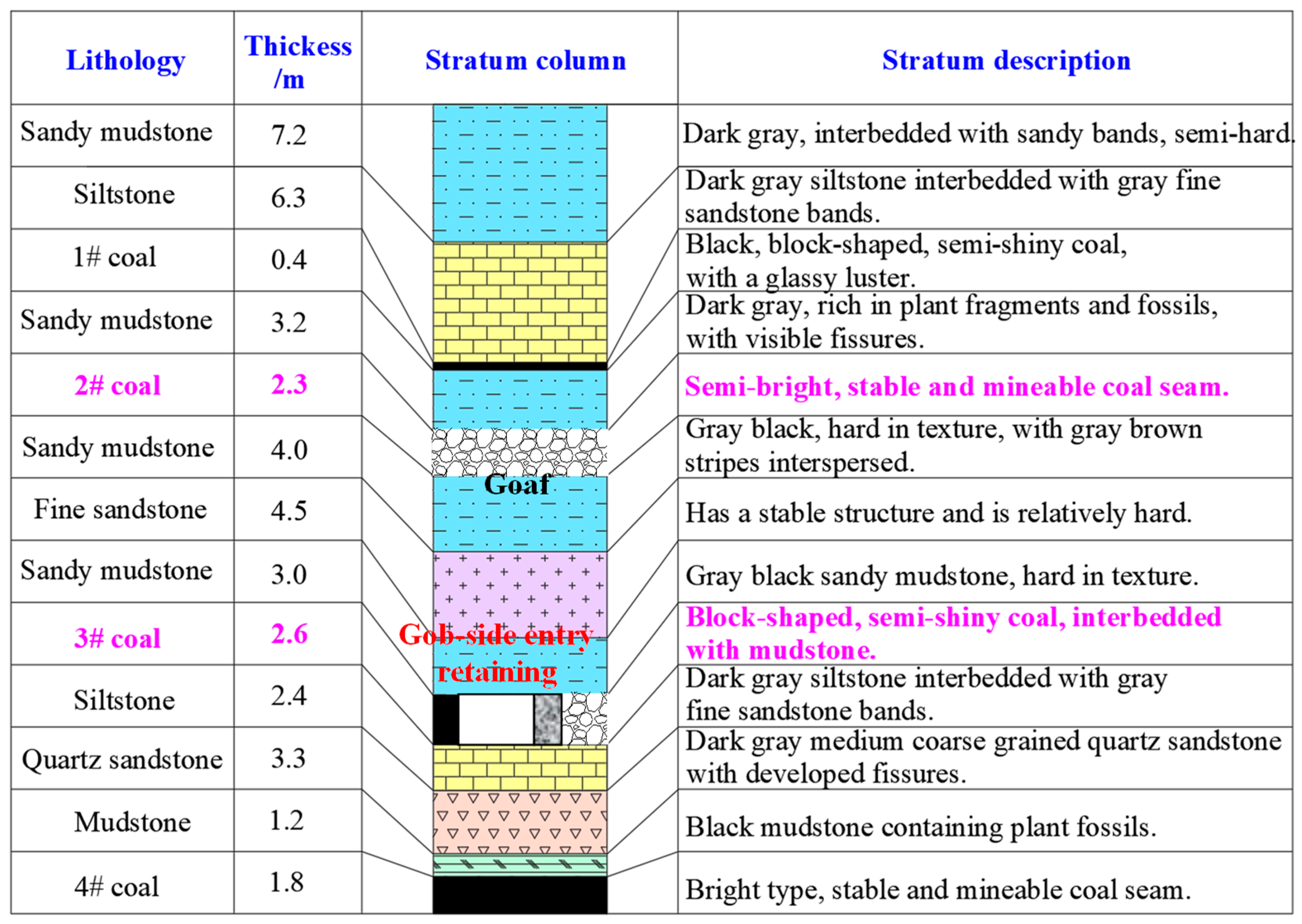
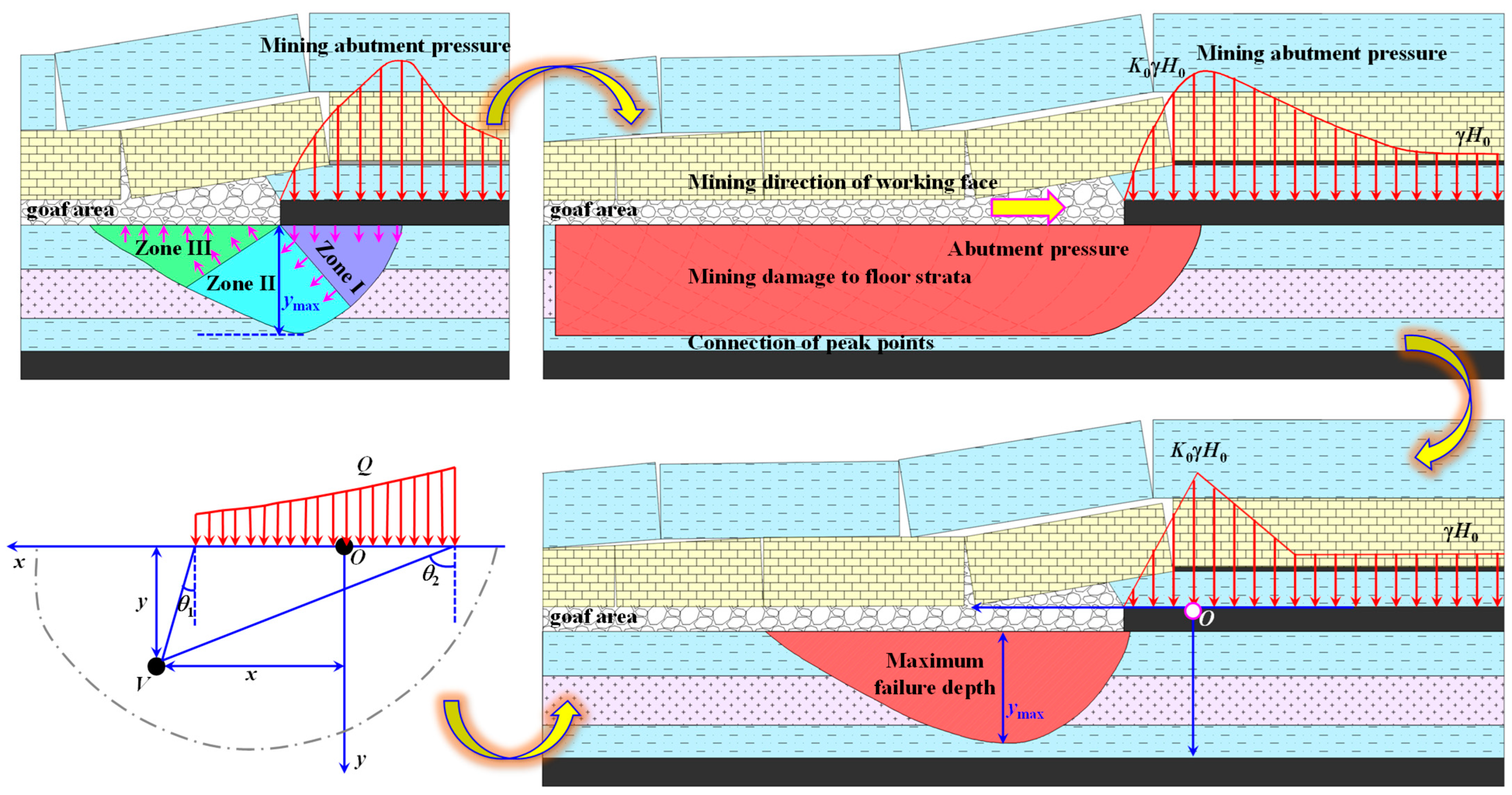




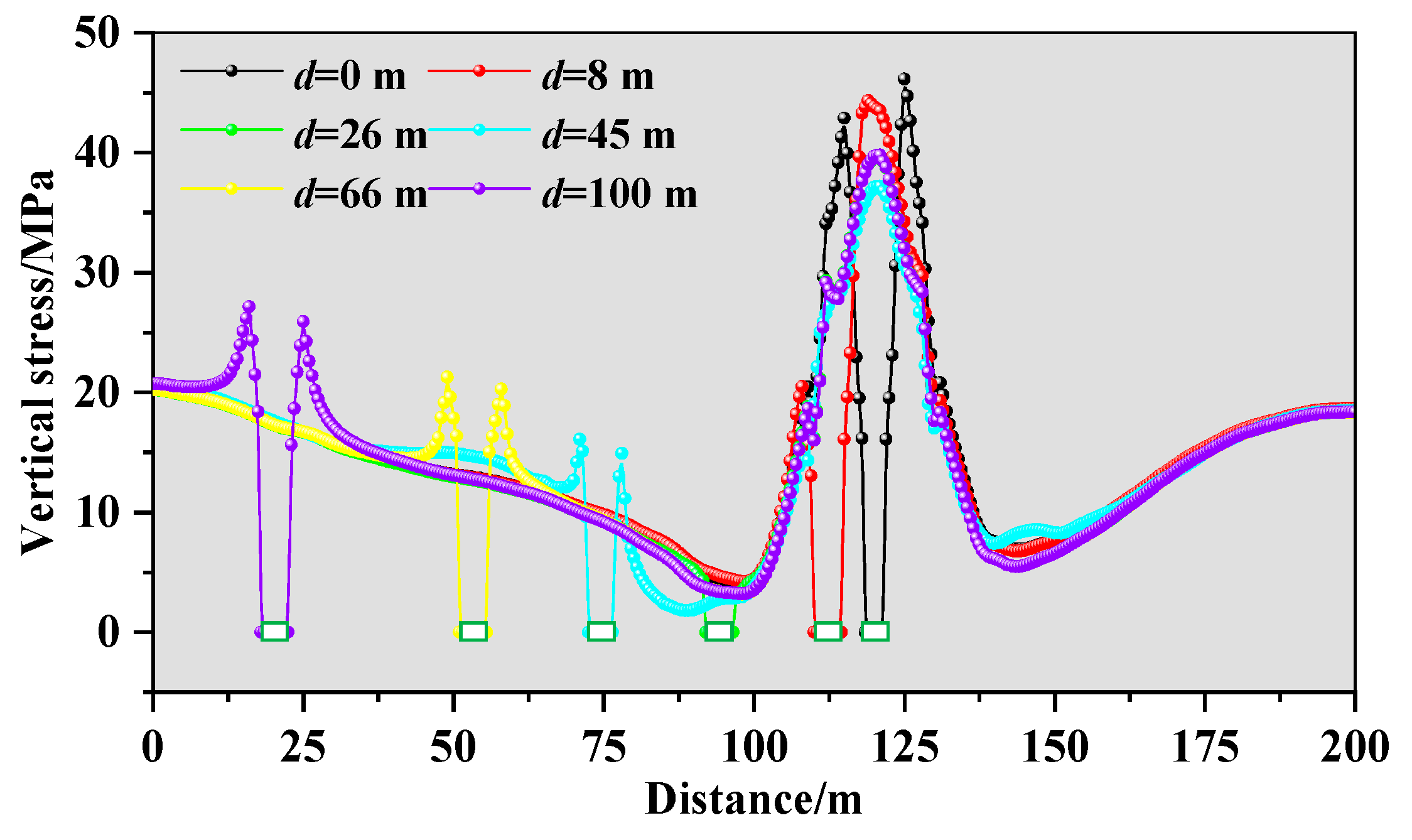
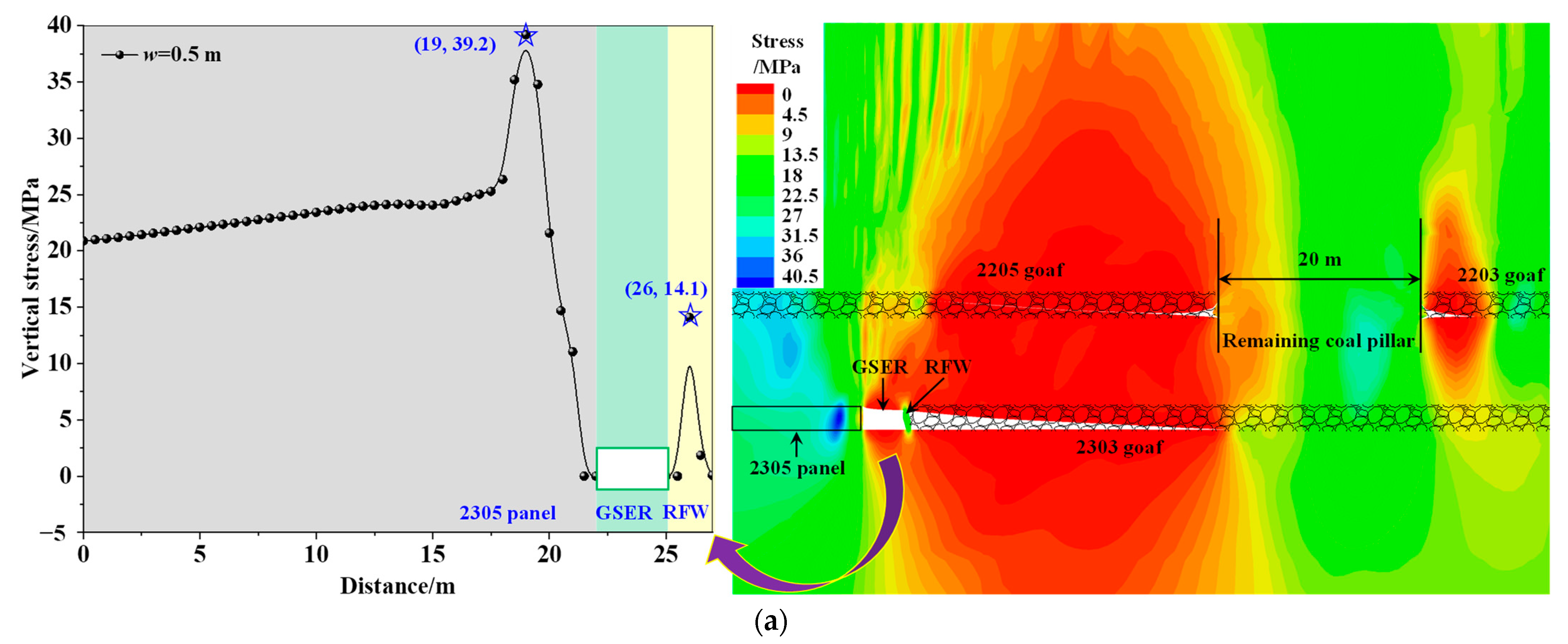
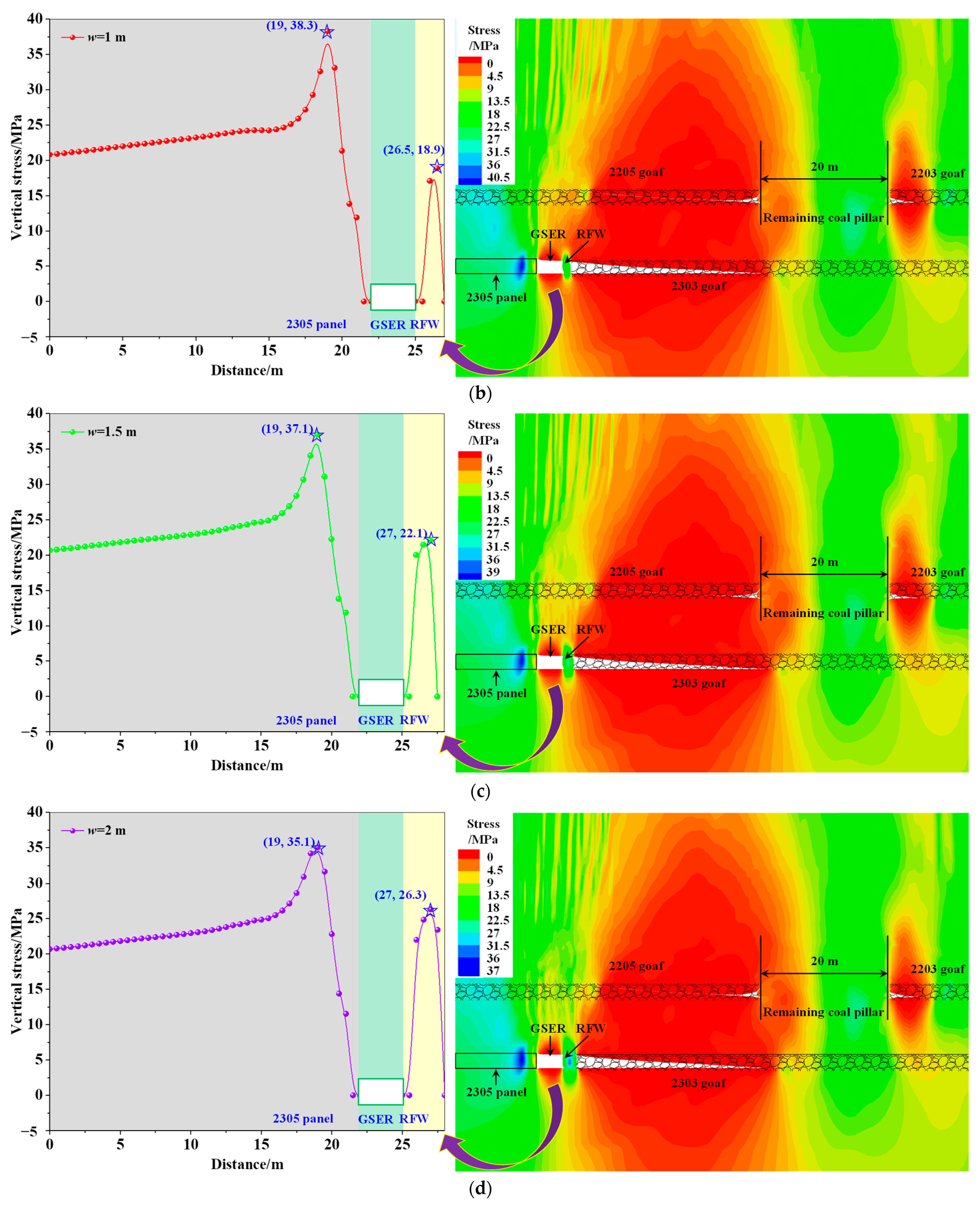
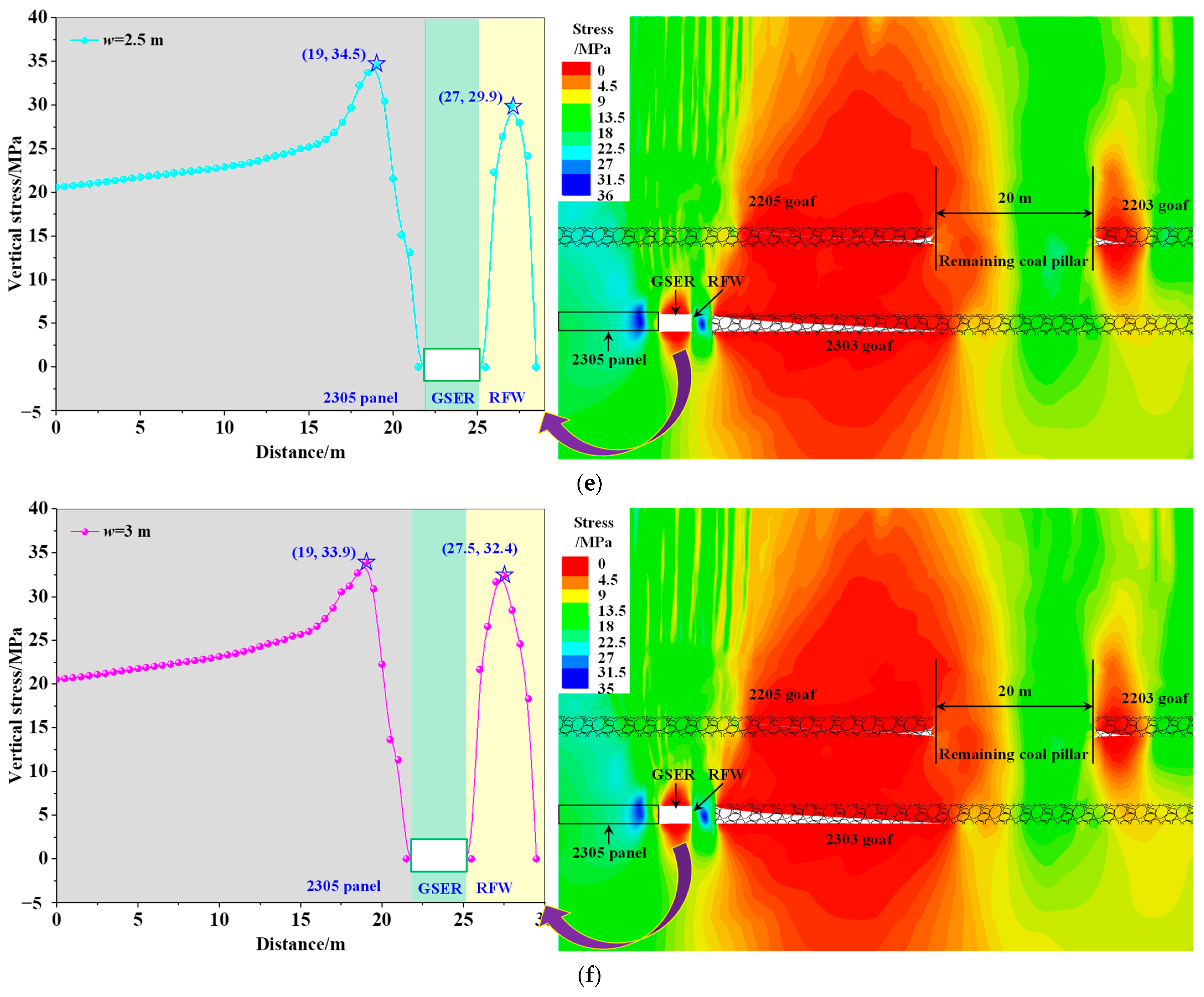
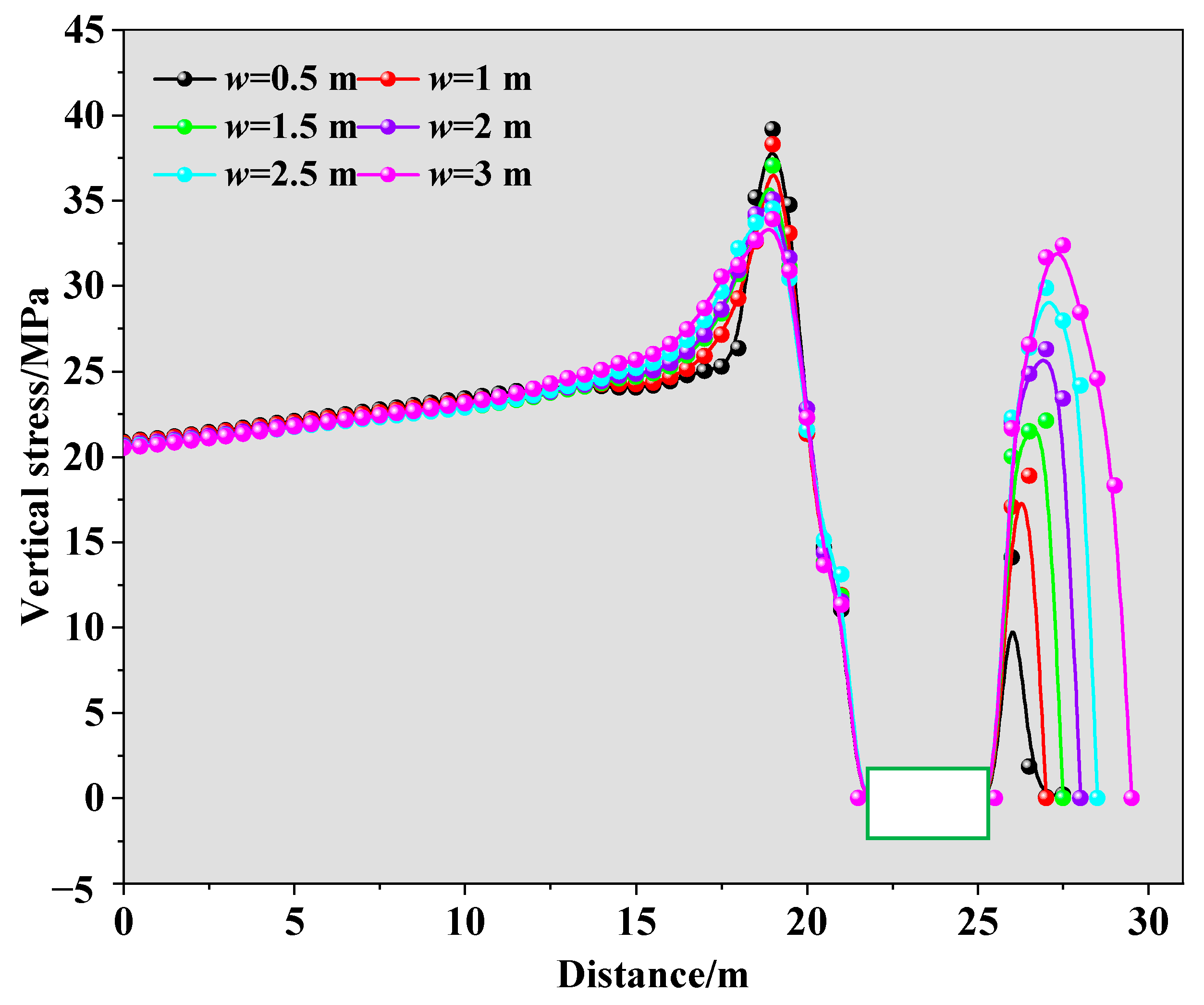

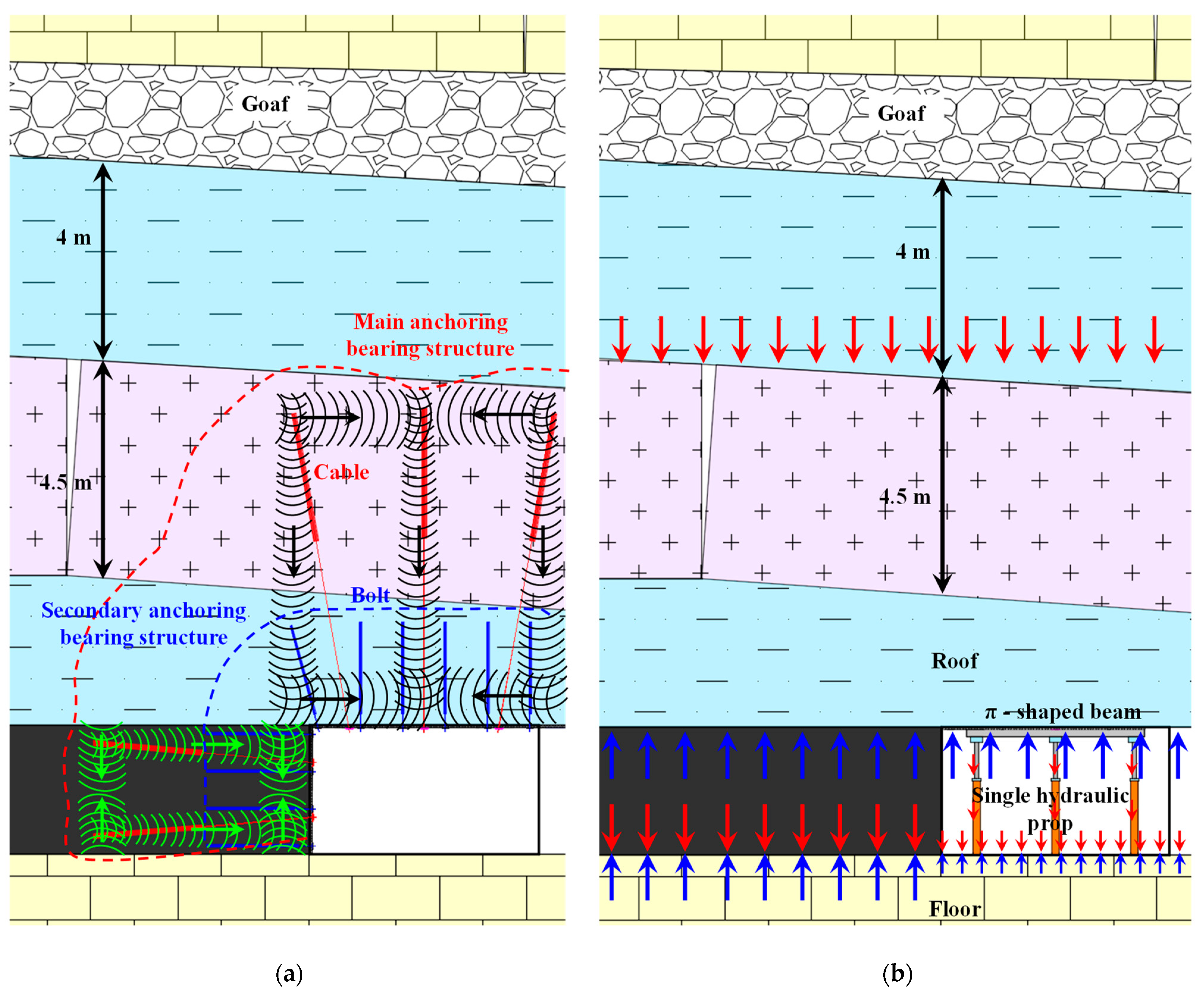
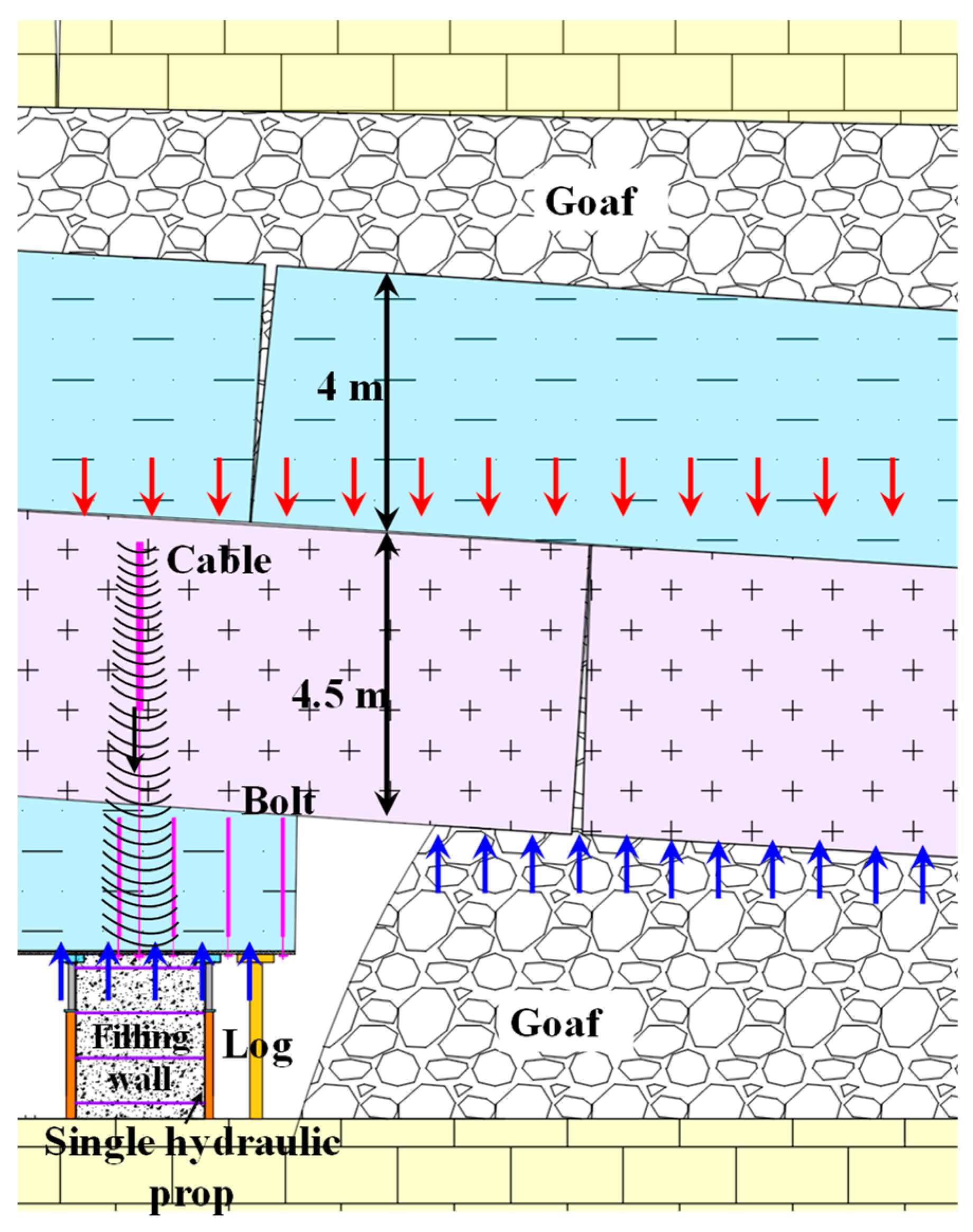
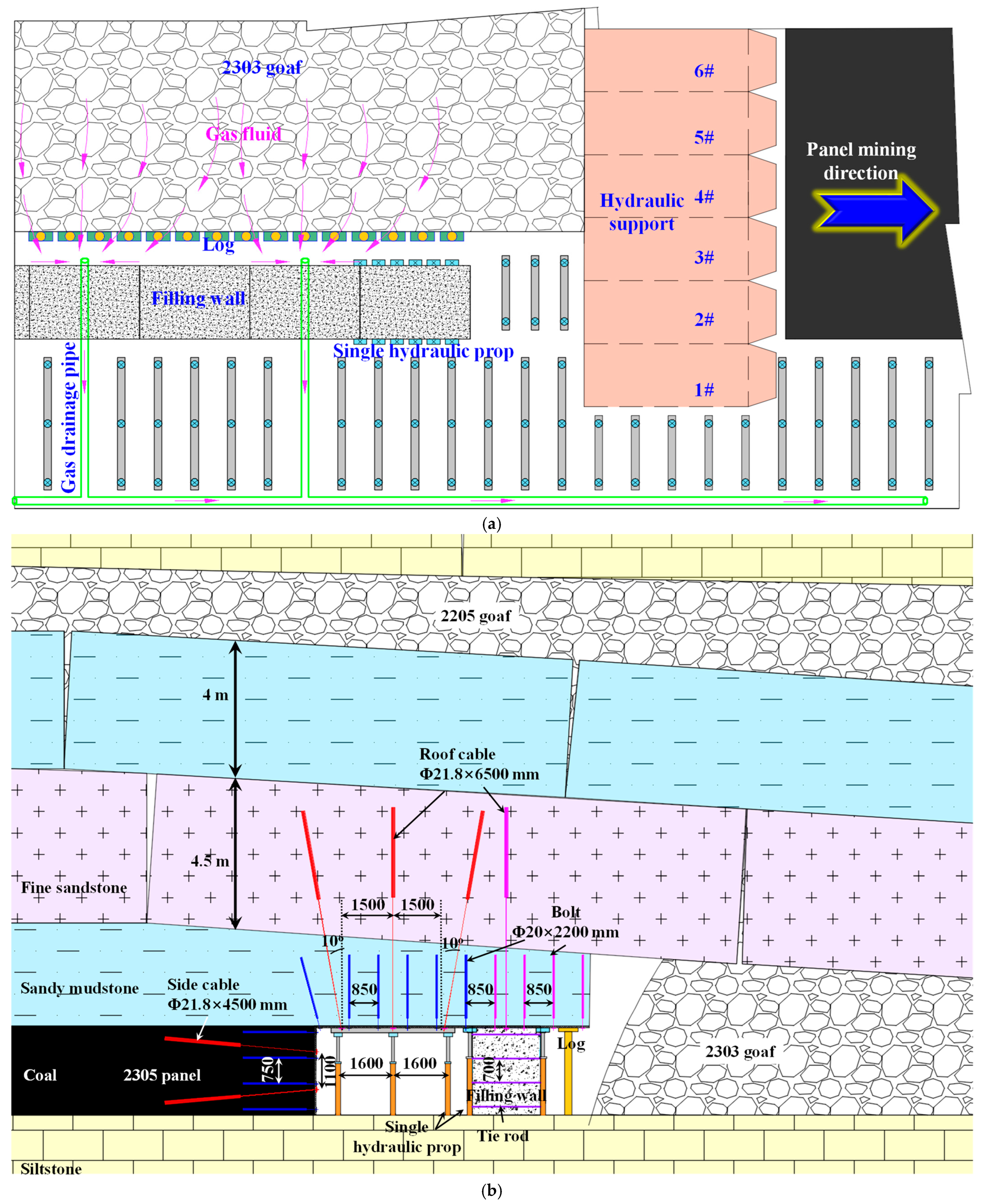
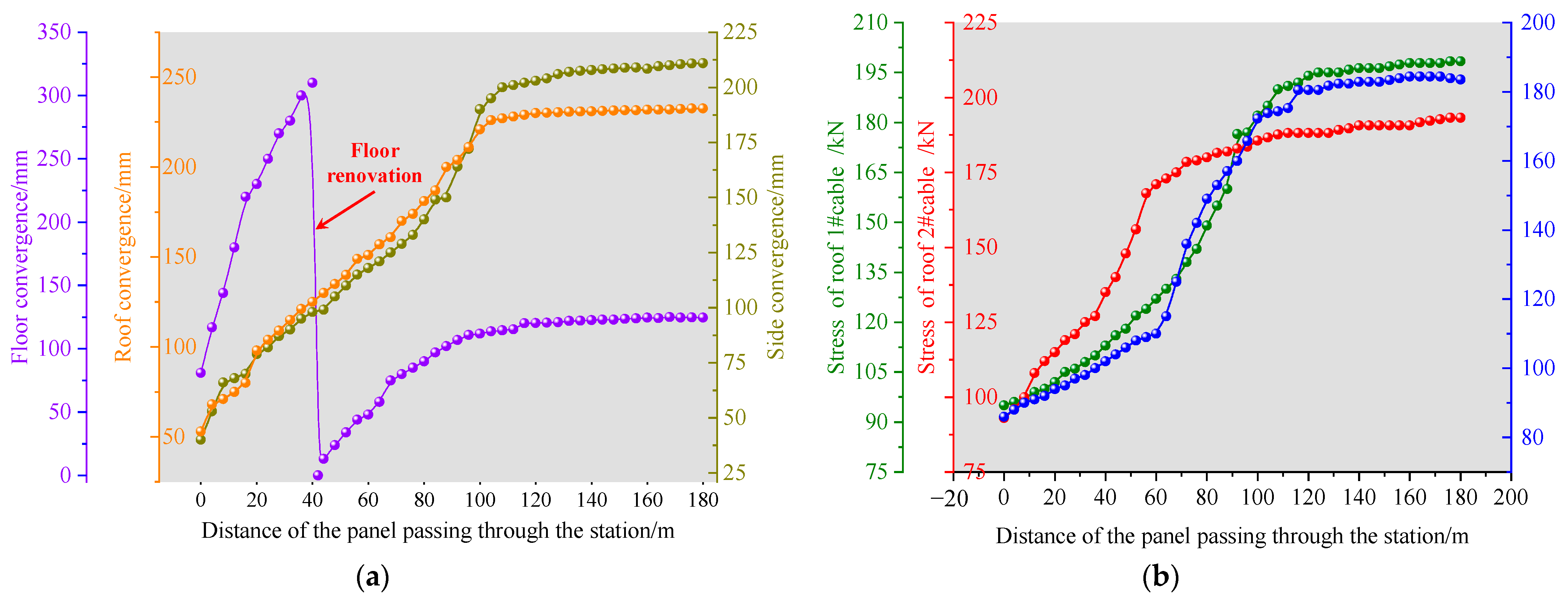

| Rock Stratum | /kg·m−3 | /GPa | /GPa | /° | /MPa | /MPa |
|---|---|---|---|---|---|---|
| Upper rock layer | 2720 | 6.68 | 7.52 | 32 | 3.42 | 2.41 |
| Sandy mudstone | 2500 | 6.72 | 5.13 | 30 | 3.11 | 2.33 |
| Siltstone | 2620 | 7.33 | 6.14 | 34 | 3.39 | 2.34 |
| Fine sandstone | 2670 | 6.52 | 5.37 | 35 | 3.71 | 2.57 |
| Coal | 1440 | 5.11 | 4.49 | 22 | 2.31 | 1.92 |
| Quartz sandstone | 2200 | 7.25 | 5.81 | 30 | 2.81 | 2.42 |
| Mudstone | 2540 | 6.45 | 5.12 | 28 | 2.69 | 2.28 |
| Lower rock layer | 2730 | 7.41 | 6.15 | 33 | 3.51 | 2.40 |
Disclaimer/Publisher’s Note: The statements, opinions and data contained in all publications are solely those of the individual author(s) and contributor(s) and not of MDPI and/or the editor(s). MDPI and/or the editor(s) disclaim responsibility for any injury to people or property resulting from any ideas, methods, instructions or products referred to in the content. |
© 2024 by the authors. Licensee MDPI, Basel, Switzerland. This article is an open access article distributed under the terms and conditions of the Creative Commons Attribution (CC BY) license (https://creativecommons.org/licenses/by/4.0/).
Share and Cite
Xie, S.; Jiang, Z.; Chen, D.; Zhai, L.; Yan, Z. Control Study on Surrounding Rock of Gob-Side Entry Retaining below near Distance Goaf. Processes 2024, 12, 1966. https://doi.org/10.3390/pr12091966
Xie S, Jiang Z, Chen D, Zhai L, Yan Z. Control Study on Surrounding Rock of Gob-Side Entry Retaining below near Distance Goaf. Processes. 2024; 12(9):1966. https://doi.org/10.3390/pr12091966
Chicago/Turabian StyleXie, Shengrong, Zaisheng Jiang, Dongdong Chen, Liwei Zhai, and Zhiqiang Yan. 2024. "Control Study on Surrounding Rock of Gob-Side Entry Retaining below near Distance Goaf" Processes 12, no. 9: 1966. https://doi.org/10.3390/pr12091966
APA StyleXie, S., Jiang, Z., Chen, D., Zhai, L., & Yan, Z. (2024). Control Study on Surrounding Rock of Gob-Side Entry Retaining below near Distance Goaf. Processes, 12(9), 1966. https://doi.org/10.3390/pr12091966






